 |
|||||
|
|||||
| Preview of Stamps Catalogue: VOLUME 1 |
 |
|||||
|
|||||
| Preview of Stamps Catalogue: VOLUME 1 |
Return To Catalogue - Natal 1874 issue - Natal 1902 and miscellaneous - South Africa
Note: on my website many of the
pictures can not be seen! They are of course present in the catalogue;
contact me if you want to purchase it.



(Reduced sizes, The embossed stamps are very badly visible)
3 p red paper 6 p green paper 9 p blue paper 1 Sh brown paper
Value of the stamps |
|||
vc = very common c = common * = not so common ** = uncommon |
*** = very uncommon R = rare RR = very rare RRR = extremely rare |
||
| Value | Unused | Used | Remarks |
| 3 p | RRR | RRR | |
| 6 p | RRR | RRR | |
| 9 p | RRR | RRR | |
| 1 Sh | RRR | RRR | |
Reprints seem to exist.
1 p red paper 1 p brown paper 1 p blue paper
Value of the stamps |
|||
vc = very common c = common * = not so common ** = uncommon |
*** = very uncommon R = rare RR = very rare RRR = extremely rare |
||
| Value | Unused | Used | Remarks |
| All values | RRR | RRR | |
Similar fiscal stamp
1 p yellow paper (perforated or imperforated)
Reprints seem to exist.

(I've been told that this is a forgery)
Some primitive forgeries:


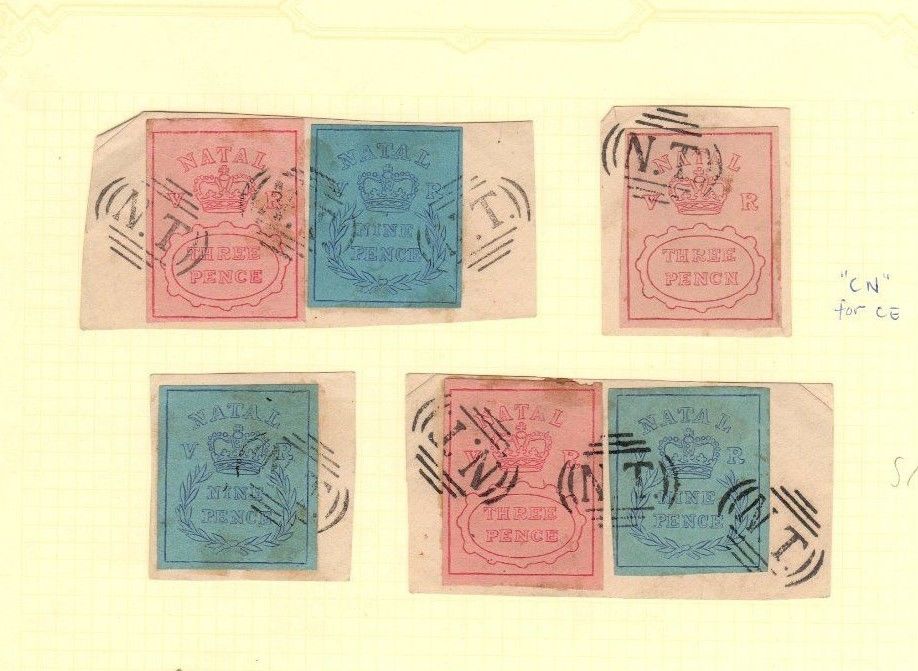
Forgeries printed with colour instead of embossing! They often
appear with a "N.T." cancel. I've also seen the 1 p red
in the above shown design with a numeral "A01" cancel.
These forgeries were most likely were modelled after
illustrations from the Moens catalogue
(Les Timbres-Poste Illustres' by J.-B.Moens 1864, Plate 23)


Another pair of forgeries obtained from the Transvaal Study
circle with the same "N.T." cancel. This cancel also
exists on forgeries of Cook Islands.
1 p red 3 p blue 6 p violet
For the specialist: these stamps were first issued without watermark in 1859 (all values). The 1 p exists with watermark 'star' (issued 1862). The 1 p and 6 p were issued with watermark 'CC crown' in 1864. I have seen an imperforate stamps of the 3 p value (however, I have also seen forged imperforate stamps of the 1 p and 3 p values, made from genuine stamps, with attached new borders!).
Value of the stamps |
|||
vc = very common c = common * = not so common ** = uncommon |
*** = very uncommon R = rare RR = very rare RRR = extremely rare |
||
| Value | Unused | Used | Remarks |
No watermark (1859) |
|||
| 1 p | RR | RR | |
| 3 p | RR | *** | |
| 6 p | RR | R | |
| Watermark 'Star' (1862) | |||
| 1 p | RR | R | |
| Watermark CC Crown, perforated 12 1/2 (1864) | |||
| 1 p | RR | R | |
| 6 p | R | *** | |
Stamps in other colours are fiscal stamps.

(6 p red and 1 p yellow fiscal stamps)
Forgeries:



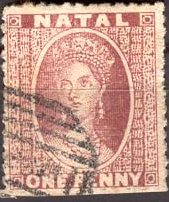


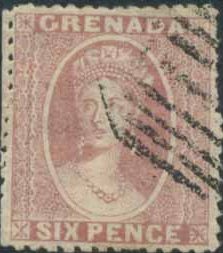


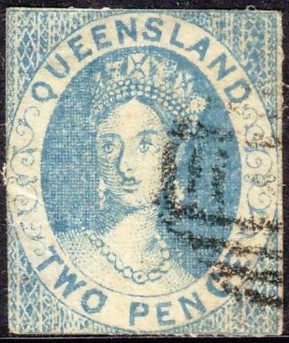
Forgeries with a very peculiar cancel. Beneath them similar
forgeries from Grenada, Bahamas and Queensland.



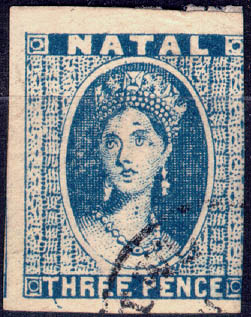


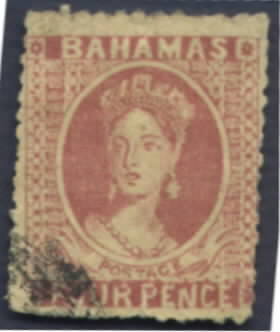
Forgeries, the Queen has a dot on her forehead. Next to it a
similar forgery from Grenada and Bahamas.
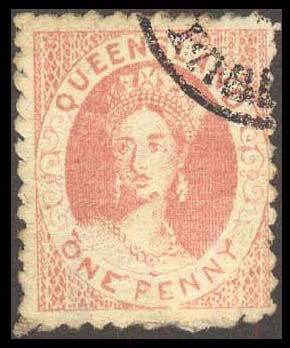
A forgery of Queensland, probably made by the same forger (note
that the same type of cancel is used as on one of the 3 p
forgeries shown above)
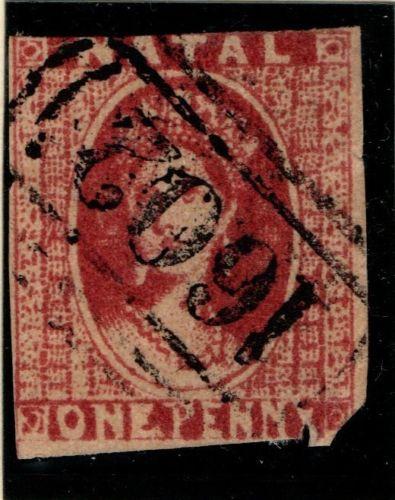
Another forgery with a "1602" cancel.

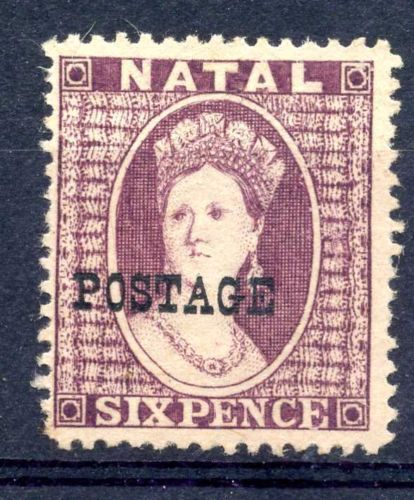


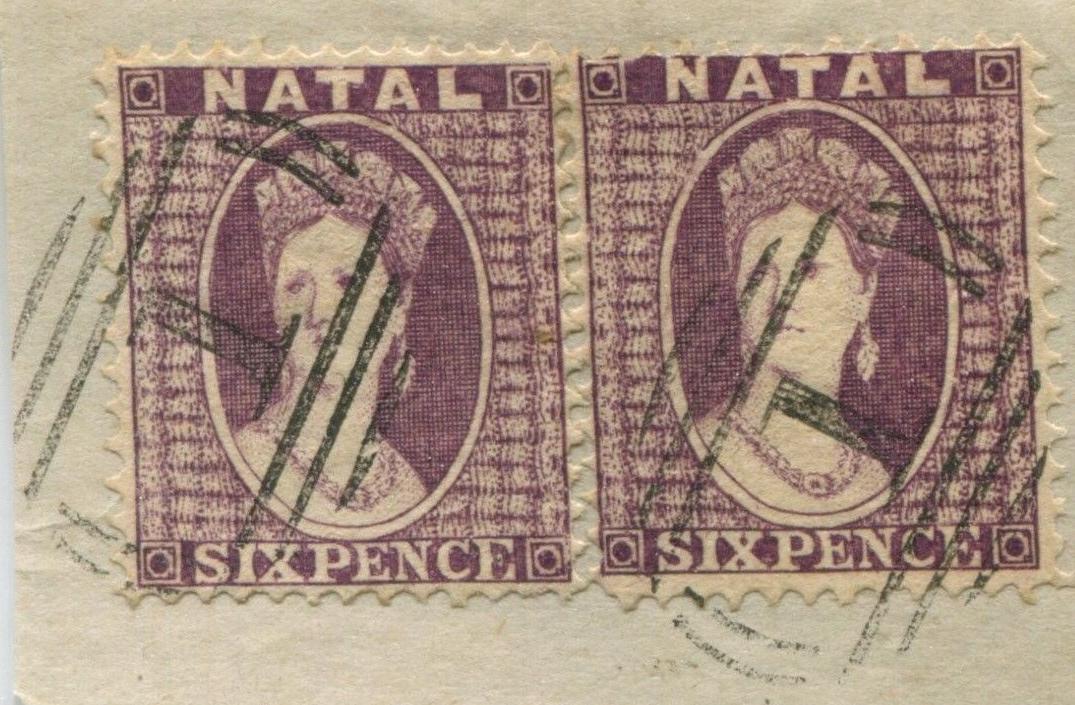
Forgeries with a slightly different facial expression, probably
of Italian origin (Oneglia). In his
1906 pricelist Oneglia lists many different types of forgeries of
the overprints. The pair appears to be two loose stamps pasted
together on one piece of paper.

Part of the page from the Fournier Album (reduced size)

Fournier forgery
In 'The Fournier Album of Philatelic Forgeries' a 6 p forgery can be found (imperforate) sold by Fournier. Apparently this forgery was not made by him, the text reads: 'Faux fabriques en Italie en 1920-1921 par la Maison V.E.U. à Gênes par un nouveau procédé' (forgeries made in Italy in 1920-21 by the house of V.E.U. in Genova with a new technique. So these forgeries were produced after Fournier had died.

In this imperforate 3 p blue forgery, the Queen looks
suspiciously to the left.
1 Sh green
Value of the stamps |
|||
vc = very common c = common * = not so common ** = uncommon |
*** = very uncommon R = rare RR = very rare RRR = extremely rare |
||
| Value | Unused | Used | Remarks |
| Watermark CC Crown, perforated 14 (1867) | |||
| 1 Sh | RR | R | |
Stamps in other colours are fiscal stamps.

(1 Sh lilac fiscal stamp)
"POSTAGE" or "Postage" horizontally: 1 p red (7 types of overprint) 1 p yellow 3 p blue (5 types of overprint) 6 p lilac (6 types of overprint) 1 Sh green (6 types of overprint)
Value of the stamps |
|||
vc = very common c = common * = not so common ** = uncommon |
*** = very uncommon R = rare RR = very rare RRR = extremely rare |
||
| Value | Unused | Used | Remarks |
| 1 p red | RR | RR | 'POSTAGE.' (1869) |
| 1 p red | RRR | RR | 'POSTAGE' (tall and no dot, 1869) |
| 1 p red | RRR | RR | 'Postage' (12 mm, 13 mm or 14 mm, 1869) |
| 1 p red | RR | RR | 'POSTAGE' smaller (1876) |
| 1 p red | RR | RR | 'POSTAGE' larger (1876) |
| 1 p yellow | RR | RR | 'POSTAGE' larger (1876) |
| 3 p | RR tp RRR | RR to RRR | All types |
| 6 p | RR to RRR | R to RRR | All types issued in 1869 |
| 6 p | RR | *** | 'POSTAGE' larger (1876) |
| 1 Sh | RR to RRR | RR to RRR | All types issued in 1869 |
| 1 Sh | RR | *** | 'POSTAGE' larger (1876) |
"POSTAGE" curved:
1 Sh green ("POSTAGE" in green, red or black)
1 Sh yellow ("POSTAGE" in red)
Value of the stamps |
|||
vc = very common c = common * = not so common ** = uncommon |
*** = very uncommon R = rare RR = very rare RRR = extremely rare |
||
| Value | Unused | Used | Remarks |
| 1 Sh green | RR | R | Overprint in red or black: RRR |
| 1 Sh yellow | *** | ** | |
"POSTAGE" twice and vertically
1 p red (2 types of overprint) 3 p blue (red overprint) 6 p lilac
Value of the stamps |
|||
vc = very common c = common * = not so common ** = uncommon |
*** = very uncommon R = rare RR = very rare RRR = extremely rare |
||
| Value | Unused | Used | Remarks |
| 1 p red | RR | *** | "POSTAGE" large |
| 1 p red | RR | RR | "POSTAGE" small |
| 3 p | RR | R | |
| 6 p | RR | RR | |
"POSTAGE" once, vertically:

1 Sh lilac
Value of the stamps |
|||
vc = very common c = common * = not so common ** = uncommon |
*** = very uncommon R = rare RR = very rare RRR = extremely rare |
||
| Value | Unused | Used | Remarks |
| 1 Sh | RR | RR | |
"POSTAGE" and value
'Half-Penny' on 1 p yellow 'Half Penny' on 6 p violet 'One Penny' on 6 p violet 'One Penny' on 6 p red
Value of the stamps |
|||
vc = very common c = common * = not so common ** = uncommon |
*** = very uncommon R = rare RR = very rare RRR = extremely rare |
||
| Value | Unused | Used | Remarks |
| 1/2 p on 1 p | R | R | 1877 |
| 1/2 p on 6 p | ** | ** | 1895 |
| 1 p on 6 p violet | R | R | 1877 |
| 1 p on 6 p red | RR | RR | 1877 |
The "Postage" overprints were made to remove the confusion between fiscal and postage stamps among the public.

Genuine stamp with forged "Postage." overprint.
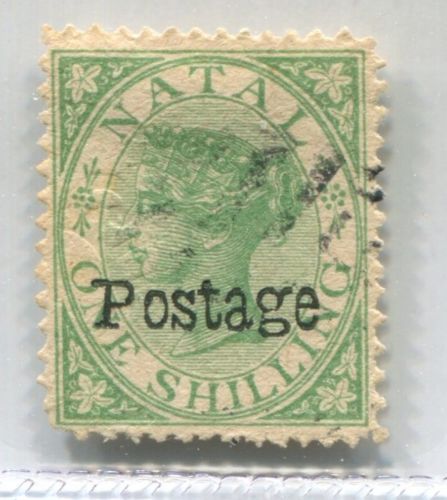
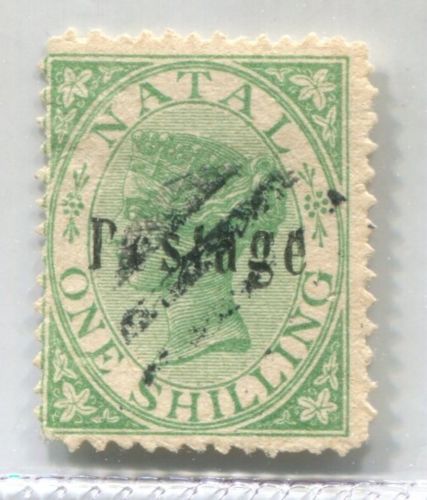
Forged stamps with forged overprints (made by Oneglia). Note the impressed watermark.
In these forgeries, the corner flowers(?) are slightly different
from the genuine stamps, also there is a green outline in front
of the face of the Queen.
For issues of Natal of 1902 and miscellaneous click here or Natal 1874 issue, click here.